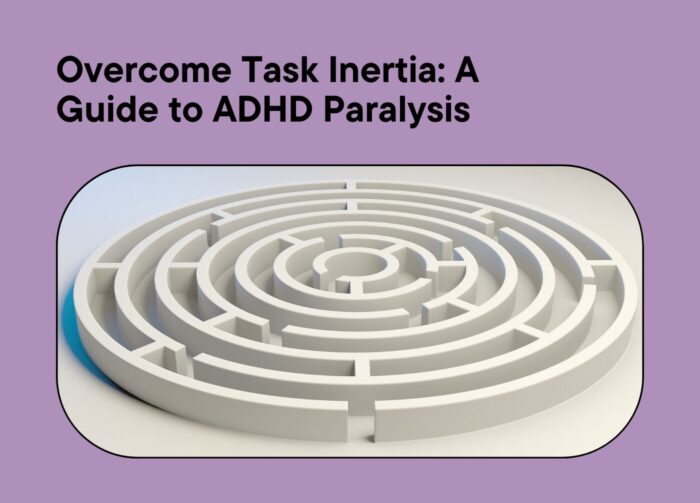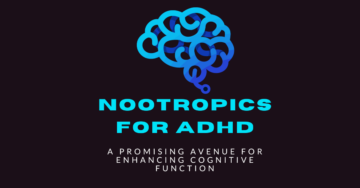Navigating the Labyrinth of ADHD Paralysis: A Guide to Overcoming Task Inertia

Attention Deficit Hyperactivity Disorder (ADHD) is a neurodevelopmental condition that affects millions of individuals worldwide. While characterized by inattention, hyperactivity, and impulsivity, many individuals with ADHD also experience a lesser-known but equally debilitating symptom – ADHD paralysis. This condition, also known as executive dysfunction or task paralysis, manifests as an inability to initiate, complete, or sustain tasks due to overwhelming feelings of anxiety, stress, or mental fatigue. It’s like being stuck in a mental fog and being unable to break free from the inertia and move forward.

While ADHD paralysis is a lesser-known symptom, it has been recognized for some time. In the 1990s, psychiatrist Russell Barkley introduced the concept of “dysexecutive syndrome,” which included task initiation and completion difficulties as core symptoms of ADHD. Over the past two decades, research has further explored the nature of ADHD paralysis and its impact on individuals’ lives.
Types of ADHD Paralysis
While ADHD Paralysis manifest in various ways, there are three primary types of ADHD paralysis that individuals commonly experience:
1. ADHD Mental Paralysis
Mental paralysis is characterized by a sense of mental fog or feeling overwhelmed, making it difficult to think clearly, concentrate, or make decisions. It’s like being stuck in a “brain freeze,” during which you are unable to process information or formulate thoughts. This type of paralysis often arises when faced with complex tasks or multiple stimuli, leading to a feeling of being overwhelmed and unable to cope.
2. ADHD Choice Paralysis
Also known as “analysis paralysis,” occurs when faced with too many options or decision points. The sheer number of possibilities can lead to overthinking, indecisiveness, and a reluctance to take action. This type of paralysis can be particularly challenging when making everyday choices, such as deciding what to wear or what to order for dinner.
3. ADHD Task Paralysis
Task paralysis involves difficulty starting or completing tasks, often due to fear of failure, perfectionism, or a lack of motivation. The task may seem overwhelming or irrelevant, triggering procrastination or avoidance. This type of paralysis can be particularly detrimental to academic performance, professional productivity, and personal goals.

Symptoms of ADHD Paralysis
While ADHD paralysis may manifest differently in individuals, there are some common ADHD paralysis symptoms that can serve as red flags indicating this challenging condition. Here’s a closer look at the key symptoms :
1. Chronic Procrastination: This is a hallmark symptom of ADHD paralysis, characterized by a persistent pattern of putting off tasks until the last minute or avoiding them altogether. This tendency to procrastinate can be deeply frustrating and have a negative impact on academic performance, professional productivity, and personal goals.
2. Difficulty Breaking Down Tasks: Large, daunting tasks can easily become overwhelming for individuals with ADHD paralysis. They may struggle to break down complex tasks into smaller, more manageable steps, making it seem like an insurmountable obstacle. This inability to compartmentalise tasks can contribute to feelings of helplessness and further hinder progress.
3. Indecision and Overthinking: ADHD paralysis often manifests as indecisiveness, leading to overthinking and analysis paralysis. The sheer number of options or decision points can be paralysing, making it difficult to make choices and take action. This indecisiveness can lead to missed opportunities and feelings of frustration.
4. Impaired Focus and Attention: Difficulty maintaining focus and attention is a common challenge for individuals with ADHD paralysis. They may find it challenging to stay on task, their attention easily drawn away by distractions or inner turmoil. This lack of focus can significantly hinder productivity and make it difficult to complete tasks.

5. Reduced Motivation and Energy: Chronic feelings of low motivation and energy can contribute to ADHD paralysis. Individuals may lack the drive or enthusiasm to initiate or complete tasks, feeling drained or unmotivated to engage in even the most mundane activities. This lack of motivation can snowball, further hindering productivity and personal growth.
6. Mental Fog or “Brain Fog”: This symptom is characterised by a sense of mental overwhelm, making it difficult to think clearly, concentrate, or process information. It’s like being stuck in a “brain freeze,” unable to make sense of the world around them. This mental fog can significantly impair cognitive function and make it challenging to complete tasks.
7. Feeling Overwhelmed or Overloaded: Individuals with ADHD paralysis often report feeling overwhelmed or overloaded by stimuli, tasks, or responsibilities. This feeling of being overwhelmed can lead to mental shutdown, preventing them from taking action or making decisions.
8. Avoidance and Escapism: To cope with the overwhelming feelings associated with ADHD paralysis, individuals may develop avoidance behaviors, such as procrastination, daydreaming, or engaging in distracting activities. This avoidance can further hinder progress and make it difficult to manage daily life.
9. Emotional Distress: ADHD paralysis can have a significant emotional impact, leading to feelings of frustration, anxiety, guilt, and low self-esteem. The inability to complete tasks or meet deadlines can contribute to these negative emotions, further exacerbating the problem.
10. Interpersonal Challenges: ADHD paralysis can strain relationships, leading to conflicts with colleagues, friends, and family members. The inability to meet commitments, complete tasks, or make decisions can cause friction and resentment in personal relationships.
It’s crucial to note that these symptoms may vary in intensity and frequency among individuals.
ADHD Paralysis vs Procrastination

While both ADHD paralysis and procrastination involve delaying or avoiding tasks, they differ in their underlying causes and impact on individuals. Understanding these distinctions is crucial to identifying the appropriate approach for overcoming these challenges.
Key Differences:
- Root Cause: Procrastination is often driven by external factors, such as laziness or lack of motivation. ADHD paralysis, on the other hand, stems from internal factors related to ADHD, such as executive dysfunction and emotional dysregulation.
- Voluntary vs. Involuntary: Procrastination is a voluntary decision to delay tasks. ADHD paralysis is an involuntary response to overwhelming emotions and cognitive challenges.
- Severity: Procrastination can vary in severity and impact on daily life. ADHD paralysis can be more severe and debilitating, significantly impacting academic performance, professional productivity, and personal well-being.
- Underlying Emotions: Procrastination may be associated with feelings of guilt, anxiety, or frustration. ADHD paralysis is often linked to overwhelming emotions such as anxiety, stress, or mental fog.
- Coping Strategies: Effective strategies for overcoming procrastination often involve addressing the underlying motivations, such as developing self-discipline, setting realistic goals, and seeking motivation. For ADHD paralysis, effective strategies focus on managing executive function, reducing emotional overwhelm, and developing coping mechanisms.
What Causes ADHD Paralysis
Although the exact causes of ADHD paralysis remain under investigation, research suggests a combination of factors contribute to this challenging condition:
1. Neurobiological Differences: Individuals with ADHD exhibit differences in brain structure and function, particularly in regions associated with executive function. These differences can impair the ability to plan, organize, prioritize, and initiate tasks, contributing to ADHD paralysis.
2. Overstimulation and Sensory Overload: ADHD individuals are more susceptible to sensory overload, experiencing a heightened sensitivity to stimuli. When faced with multiple tasks, distractions, or complex information, the brain may become overloaded, leading to mental shutdown and task paralysis.
3. Emotional Factors: Emotional dysregulation, a common feature of ADHD, can play a significant role in ADHD paralysis. Anxiety, perfectionism, and fear of failure can trigger avoidance behaviors and make it difficult to initiate or complete tasks.
4. Perfectionism: A common trait among individuals with ADHD, can lead to procrastination and task paralysis. The fear of making mistakes or not meeting unrealistic expectations can prevent individuals from taking action, leading to a cycle of avoidance and guilt.
5. Motivational Issues: Low motivation and energy can contribute to ADHD paralysis. Individuals may lack the drive or enthusiasm to engage with tasks, feeling drained or apathetic. This lack of motivation can further hinder productivity and progress.
6. Life Stressors: Such as relationship problems, financial worries, or work-related stress, can exacerbate ADHD paralysis. These external stressors can add to the cognitive load and emotional overwhelm, making it even more difficult to function effectively.
7. Sleep Deprivation: Adequate sleep is essential for cognitive function and emotional regulation. Sleep deprivation can worsen symptoms of ADHD, including executive dysfunction, emotional dysregulation, and procrastination, making it more likely to experience ADHD paralysis.
8. Underlying Medical Conditions: Certain medical conditions, such as anxiety disorders, depression, or thyroid imbalance, can mimic the symptoms of ADHD paralysis and should be ruled out. Addressing these underlying conditions can help improve overall well-being and reduce the severity of ADHD paralysis.
9. Inadequate Treatment: Inadequate or inconsistent treatment for ADHD can contribute to ADHD paralysis. Medications and therapies can help improve executive function, reduce anxiety and emotional dysregulation, and improve motivation.
Effects of ADHD Paralysis on Everyday life

ADHD paralysis can cast a long shadow over daily life, affecting various aspects of our existence. It’s not just about tasks and responsibilities; it’s about the way we feel, the relationships we build, and our overall well-being. Some of the most well documented effects of ADHD Paralysis are as follows:
Academic Hurdles
- Inability to focus, organize thoughts, and complete assignments
- Poor grades, academic struggles, and a constant feeling of inadequacy
Professional Obstacles
- Missed deadlines, unfulfilled projects, and strained relationships
- Inability to manage tasks effectively, make decisions, or meet expectations
- Hindered career advancement and a trail of disappointments
Social Strains
- Inability to plan social activities, keep commitments, or make meaningful contributions
- Feelings of isolation and misunderstandings with friends and family
Emotional Rollercoaster
- Feelings of guilt, frustration, and low self-esteem
- Constant struggle to overcome tasks, perception of being unproductive, and impact on daily lives
- Erosion of self-worth and trapped in a cycle of despair
Sleepless Nights and Physical Strain
- Constant worry and anxiety associated with ADHD paralysis
- Sleep disturbances, exacerbating symptoms, and contributing to physical health issues
- Inability to relax, fear of not getting things done, and constant mental chatter
- Exhaustion and physical unwellness
How to Get Out of ADHD Paralysis

While this condition can be challenging, there are effective strategies to break free from its grip and regain control of your life. Here are ten practical tips to help you overcome ADHD paralysis:
- Embrace Self-Compassion: Beating yourself up over procrastination or task avoidance only exacerbates the problem. Instead, practice self-compassion and acknowledge that ADHD paralysis is a common challenge. Approach each task with a sense of curiosity and determination, rather than self-criticism.
- Identify Your Triggers: Recognising the specific situations, emotions, or tasks that trigger ADHD paralysis is crucial for developing effective coping mechanisms. Once you understand your triggers, you can anticipate them and develop strategies to manage them.
- Break Down Tasks into Smaller Steps: Large, daunting tasks can easily overwhelm individuals with ADHD paralysis. Break down complex tasks into smaller, more manageable steps to make them less intimidating and increase the likelihood of completion. This approach makes tasks feel more achievable and reduces the overall stress associated with them.
- Leverage Technology to Your Advantage: Utilize task management apps, calendars, and reminders to stay on track and avoid procrastination. These tools can help you organize your thoughts, schedule tasks, and set reminders, making it easier to stay focused and motivated.
- Prioritize Sleep and Self-Care: Adequate sleep is essential for cognitive function and emotional regulation. Aim for 7-8 hours of quality sleep each night to reduce stress, improve focus, and enhance overall well-being. Additionally, prioritize self-care practices like exercise, healthy eating, and stress-management techniques to support your overall health and well-being.
- Engage in Mindful Practices: Mindfulness techniques such as meditation and deep breathing can help manage stress, improve emotional regulation, and boost focus. These practices can be especially helpful when you feel overwhelmed or stuck in a state of procrastination.
- Seek Support from Loved Ones: Share your struggles with ADHD paralysis with supportive friends and family members. Their understanding and encouragement can provide motivation and accountability, making it easier to overcome challenges. Consider forming a support group or finding an ADHD mentor to connect with others facing similar challenges.
- Celebrate Small Victories: Acknowledge and celebrate your accomplishments, no matter how small. Positive reinforcement can boost motivation, maintain momentum, and reinforce the progress you are making. Recognizing your achievements, no matter how seemingly insignificant, can help you stay on track and overcome obstacles.
- Seek Professional Guidance: If ADHD paralysis is significantly impacting your daily life, consider seeking professional support from a therapist or ADHD specialist. They can provide personalized strategies, assess underlying causes, and recommend appropriate treatment options, such as medication or therapy.
- Embrace Flexibility and Prioritize Progress over Perfection: ADHD paralysis can make it difficult to achieve perfection in every task. Instead, focus on making progress, even if it’s incremental. Celebrate your efforts and don’t get discouraged by setbacks. Remember, consistency and effort are more important than achieving unattainable standards of perfection.
Treatment for ADHD Paralysis
Treatment for ADHD paralysis typically involves a combination of approaches, including medication, therapy, and lifestyle modifications. The specific combination of treatments will vary depending on the individual’s needs and preferences.
Medication

Medications can be an effective part of ADHD treatment, helping to improve executive function, reduce symptoms such as hyperactivity and impulsivity, and improve focus and attention. Medications such as stimulants and non-stimulants can be prescribed by a doctor or psychiatrist.
Therapy
Therapy can be an invaluable tool for individuals with ADHD paralysis. Cognitive behavioral therapy (CBT) is particularly effective for addressing ADHD symptoms, including task initiation, organization, and procrastination. CBT can help individuals develop strategies to manage their thoughts, emotions, and behaviors, and improve their ability to cope with stress and anxiety.
Lifestyle Modifications
Lifestyle modifications can also play a significant role in managing ADHD paralysis. These include:
- Adequate sleep: Getting enough quality sleep is essential for improving cognitive function and reducing stress, both of which can contribute to ADHD paralysis. Aim for 7-8 hours of sleep per night.
- Regular exercise: Exercise has been shown to improve focus, attention, and mood, all of which can help individuals with ADHD paralysis overcome challenges. Aim for at least 30 minutes of moderate-intensity exercise most days of the week.
- Healthy diet: A balanced diet provides the body with the nutrients it needs to function optimally. Avoid processed foods, sugary drinks, and excessive caffeine.
- Stress management: Stress can exacerbate ADHD symptoms and make it difficult to focus. Practice stress-management techniques such as meditation, deep breathing, or yoga.
Seeking Professional Support
If you are struggling with ADHD paralysis, it is important to seek professional support. A therapist or ADHD specialist can assess your individual needs and develop a personalized treatment plan that includes medication, therapy, and lifestyle modifications. With the right treatment and support, you can overcome ADHD paralysis and achieve your goals.
Conclusion
ADHD paralysis is a lesser-known but debilitating symptom of ADHD that can significantly hinder academic performance, professional productivity, and personal well-being. It manifests as an inability to initiate, complete, or sustain tasks due to overwhelming feelings of anxiety, stress, or mental fatigue. While it may seem like ADHD paralysis is an insurmountable obstacle, there are effective strategies to break free from its grip and regain control of your life. Here are some key takeaways from the article:
- ADHD paralysis is a symptom of ADHD, not a sign of weakness or laziness.
- ADHD paralysis can manifest in various ways, including mental fog, choice paralysis, and task paralysis.
- The causes of ADHD paralysis are complex and may include neurobiological differences, overstimulation, emotional dysregulation, perfectionism, motivational issues, and life stressors.
- Effective strategies for overcoming ADHD paralysis include self-compassion, identifying triggers, breaking down tasks, leveraging technology, prioritizing sleep and self-care, engaging in mindful practices, seeking support from loved ones, celebrating small victories, seeking professional guidance, and embracing flexibility.
- Treatment for ADHD paralysis typically involves a combination of medication, therapy, and lifestyle modifications.
Remember, with the right treatment, support, and coping strategies, you can overcome ADHD paralysis and achieve your goals.
FAQs
How long does ADHD Paralysis last?
ADHD paralysis is a chronic condition that can last indefinitely, but with effective treatment and coping strategies, the symptoms can be managed and reduced. The duration of individual episodes of paralysis can vary depending on various factors, including the severity of ADHD symptoms, stress levels, coping mechanisms, and treatment adherence.
What are ADHD shutdown symptoms?
ADHD shutdown, also known as ADHD inertia or ADHD paralysis, is a debilitating symptom of attention deficit hyperactivity disorder (ADHD) that can significantly impact an individual’s daily life. It manifests as an inability to initiate, complete, or sustain tasks due to overwhelming feelings of anxiety, stress, or mental fatigue.
Typical ADHD shutdown symptoms include:
- Mental fog or “brain fog”: Difficulty thinking clearly, concentrating, or processing information.
- Choice paralysis: Indecisiveness and difficulty making decisions due to feeling overwhelmed by options.
- Task paralysis: Difficulty starting or completing tasks, often due to fear of failure, perfectionism, or lack of motivation.
- Avoidance and escapism: Engaging in distracting activities to avoid dealing with tasks or responsibilities.
- Emotional distress: Feelings of frustration, anxiety, guilt, and low self-esteem.
- Physical strain: Sleep disturbances, headaches, and overall physical exhaustion.
Is ADHD paralysis serious?
Yes, ADHD paralysis can be a serious and debilitating condition. It can significantly impact an individual’s daily life, affecting their academic performance, professional productivity, and personal well-being. The inability to initiate, complete, or sustain tasks can lead to frustration, anxiety, guilt, and low self-esteem. Moreover, ADHD paralysis can have a ripple effect on other areas of life, such as relationships,
Is ADHD paralysis common?
Yes, ADHD paralysis is a common symptom of ADHD. It is estimated that approximately 75% of individuals with ADHD experience some degree of task paralysis. The severity and frequency of these episodes can vary from person to person, but it is a significant challenge that can significantly impact quality of life.
Can stress cause ADHD paralysis?
Yes, stress can be a significant trigger for ADHD paralysis. When individuals with ADHD are stressed, their executive function, which is responsible for planning, organizing, and initiating tasks, can become impaired. This can make it even more difficult to start or complete tasks, leading to feelings of overwhelm and paralysis.
References
- Enright, J., 2021. ADHD Paralysis Explained. Retrieved May, 22, p.2023.
- Pearl, P.L., Weiss, R.E. and Stein, M.A., 2001. Medical mimics: Medical and neurological conditions simulating ADHD. Annals of the New York Academy of Sciences, 931(1), pp.97-112.
- Stavraki, I., What Is ADHD Executive Dysfunction?
- Barbosa, M. and Guedes, R., 2022. Adult attention-deficit/hyperactivity disorder and bipolar disorder: diagnostic and management challenges. European Psychiatry, 65(S1), pp.S466-S467.
- Seidman, L.J., Biederman, J., Weber, W., Hatch, M. and Faraone, S.V., 1998. Neuropsychological function in adults with attention-deficit hyperactivity disorder. Biological psychiatry, 44(4), pp.260-268.
- Hendrickx, S., 2010. The adolescent and adult neuro-diversity handbook: Asperger’s syndrome, ADHD, dyslexia, dyspraxia, and related conditions. Jessica Kingsley Publishers.





